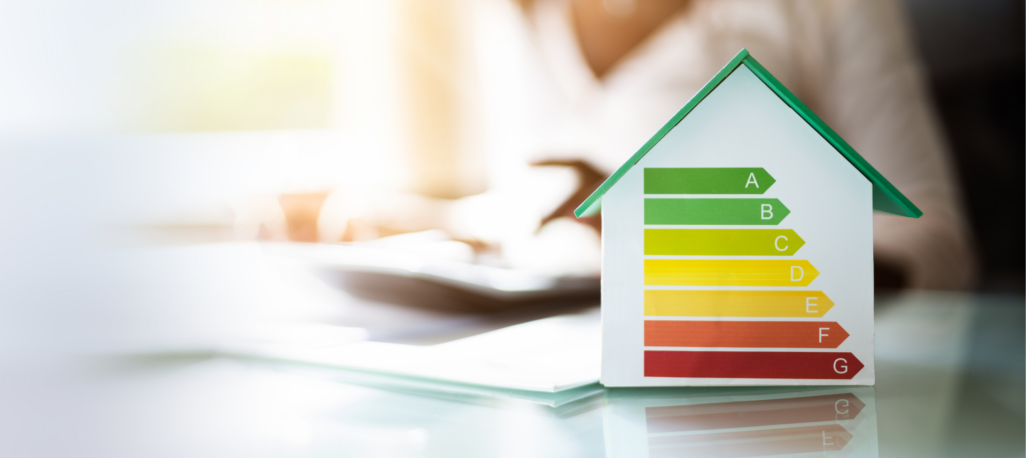At a time in which our energy consumption and the related costs are steadily rising and environmental problems are becoming increasingly apparent, it is more important than ever to pay attention to the energy efficiency of our household appliances. In this blog post, klimaaktiv Haushalte shows how the energy label on electrical appliances helps you choose an energy-efficient appliance and what is still useful to consider before a new purchase.
The energy label on electrical appliances is a type of quality seal that helps us recognise the energy efficiency of a household appliance at first glance. The energy label divides household appliances into various energy efficiency classes using a scale from A (very energy efficient) to G (least energy efficient). A colour gradient from green (A) to yellow (D) to red (G) visually aids the scale. Of course, the greener the label on an appliance, the more efficient it is. As a rule, it can be found on electrical appliances such as refrigerators, washing machines, dishwashers and many other items. The label provides information about the appliance’s energy consumption as well as the general environmental impact, thus enabling us to make more conscious decisions and permanently reduce our electricity bill.
Purchasing recommendation for refrigerators and freezers
Electricity consumption for refrigerators and freezers in the household averages 10 to 15 percent. Refrigerators without a freezer compartment require about 20 to 25 percent less energy than appliances with a freezer compartment. Refrigerator-freezer combinations should have separate doors for the compartments. If there is already a freezer in the kitchen or if there is a plan to purchase one, a refrigerator without a freezer compartment would be the energy-saving choice.
topprodukte.at recommends choosing a product in efficiency class A to D when purchasing refrigerators and freezers. In addition to the energy efficiency class, the energy label also shows the appliance’s annual electricity consumption, total storage capacity, noise emissions and the total volume of all cooling compartments. To get the most out of the appliance, choose an appliance size to suit your household size.
Purchasing recommendation for dishwashers
The energy and water consumption of dishwashers has a significant impact on your energy costs. The most economical dishwashers currently available correspond to efficiency classes A to C. On average, a dishwasher in energy class A requires about 29 percent less electricity than a class C appliance. In addition to the energy efficiency class, the energy label also shows the energy consumption of the Eco programme for 100 cycles (kWh), dish capacity, the duration of the Eco programme in hours and minutes, noise emissions and the noise emission class, and the water consumption of the Eco programme per programme cycle (litres).
The choice of model and appliance size depends primarily on the space available, the size of the household and the amount of dishes to be washed. Dishwashers come in two standard sizes: 45 cm and 60 cm wide. The narrower models are usually designed for nine to ten place settings and consume more energy and water than the wider models (usually for 12 to 15 place settings) in relation to the load.
Washing dishes in a dishwasher is more efficient than washing them by hand. Washing by hand uses about a quarter more energy and four times as much water (AEA, 2022).
Purchasing recommendation for washing machines
The energy and water consumption of washing machines has a considerable impact on your total operating costs. The most economical washing machines currently available correspond to efficiency classes A to B. In addition to the energy efficiency class, the energy label also shows the weighted energy consumption for 100 programme cycles (kWh), the load capacity for the “Eco 40-60” programme (kg), the spin efficiency, the duration of the “Eco 40-60” programme in hours and minutes, noise emissions during the spin cycle and the weighted water consumption per programme cycle (litres).
When purchasing washing machines, you should choose an efficiency class A or B product. On average, a washing machine with energy class A and a 7 kg load capacity requires about 50 percent less electricity than a class F appliance. You will also save money in the long run if you choose a capacity that fits the size of your household. While a 5 kg machine is sufficient for a single household, models with up to 7 kg are generally suitable for households with three to four people.
If the laundry is dried with a dryer, pay attention to the spin speed when purchasing a new washing machine, because the better the laundry is pre-spun, the shorter the drying process will be. topprodukte recommends spin class A.
A move is the perfect time to take a close look at the energy efficiency of household appliances. With new purchases, in particular, this also offers the chance to save costs and protect the environment in the long term. At klimaaktiv Haushalte you will find the most economical appliances available on the market. From energy-efficient refrigerators that keep your food fresh to energy-efficient washing machines that simultaneously protect your clothes and the environment – topprodukte has everything you need in your new home!










